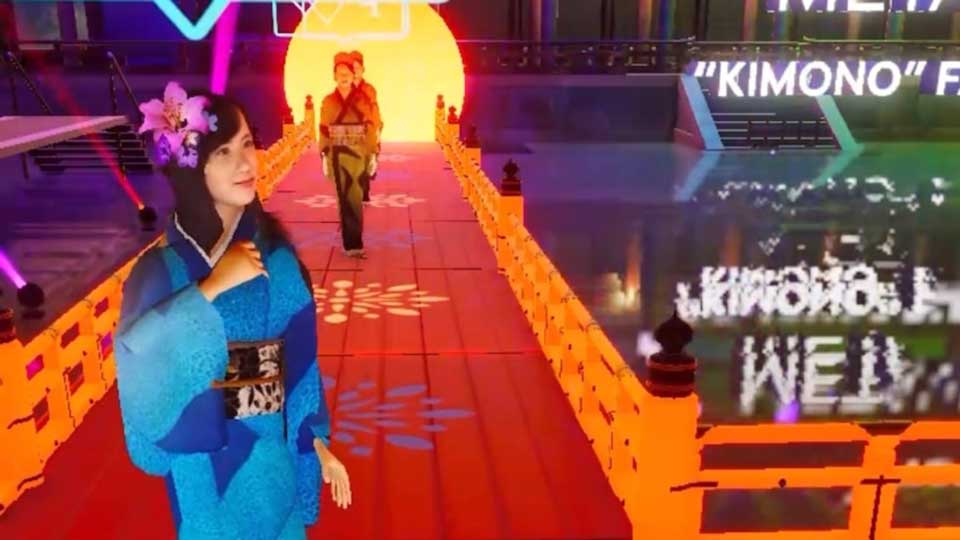Next-generation art project
Organizers call Naked Garden One Kyoto a "next-generation art project" that allows people to explore Kyoto in two worlds: real and virtual. It includes events at over 20 landmarks in and around the city. All of the locations use digital art to draw visitors at night, and some of them have virtual versions in the metaverse. The local government collaborated with a company called NAKED on the project, which started on September 15 and runs through December 25.
Nijo-jo lights up at night
Nijo-jo, a castle with deep ties to the Tokugawa Shogunate, is one locale. The UNESCO World Heritage site has always been a popular destination for daytime visitors. Thanks to digital art, now it's drawing crowds at night.
One castle gate, known as Kara-mon, has intricate carvings of creatures deemed lucky, from cranes to dragons. For the event, a phoenix is projected onto the gate. The magnificent entrance of the mythical bird is just the first of many digital art installations on show at the castle during the night.
This isn't the first time Nijo-jo has been given new life at night thanks to digital art. The company that created the works has produced similar events in the past, and their success led to the current city-wide project. However, there's a new feature this time around: a metaverse Kyoto.
Metaverse Nijo-jo encourages people to visit in person
Nijo-jo was recreated in the virtual world so that people from around the globe could enjoy the castle and the same digital art in avatar form. The key is that this metaverse can be joined via smartphone. The goal is to have as many people as possible visit the metaverse Kyoto, so it's in a format that doesn't require expensive headsets. By making virtual tours accessible and jazzing up the historic site, Kyoto hopes to encourage people to visit the city in person, but not like in the past.
Kyoto City aims to reinvent tourism
The city of Kyoto was a tourist destination for over 50 million people before the pandemic, which created a few issues for the local government.
One problem was overcrowding. Visitors tended to choose the same destinations at the same time: during daylight hours. That caused traffic congestion, littering, and many other problems associated with excessive tourism.
Naked Garden One Kyoto is aimed at dispersing crowds by focusing on different times of day. Kyoto City official Hara Tomoharu notes "by promoting tourism at night, we want to reduce daytime congestion." He adds that by making the event spotlight over 20 landmarks in and around the city, visitors will be more spread out.

Another reason Kyoto wants to reinvent tourism is revenue. Visitors who stay the night end up paying or dinner and accommodations in Kyoto, so they spend three to five times more than the people who only make a day trip. However, only a quarter of visitors actually sleep in Kyoto.

That means Kyoto experienced the negative effects of excessive tourism but did not reap the full financial benefits. Data indicates that if more visitors spend the night, the city would enjoy a significant increase in tourism income. Nighttime events like the one this autumn may incentivize visitors to book a stay.
Tourism in the post-pandemic world
Though Kyoto City wants more visitors, it hasn't forgotten the realities of the pandemic. At venues where large crowds are anticipated, installations help prevent the spread of viruses.
The "social distancing lantern" projects a pattern of light onto the ground around the user, making visitors aware of their distance from others. The art takes full advantage of the fact that the event is held when it's dark. Another installation with a similar goal is a projection mapping display for the hands. When visitors show their palms beneath a machine, the motifs each landmark is known for appear. At the end, alcohol is sprayed onto the hands. Both features make preventative measures enjoyable.

Behind the scenes
Behind the Naked Garden One Kyoto project is the company NAKED, which excels at digital art. It made a name for itself creating installations that use projection mapping, but it was new to working on a project that combines historical venues and computer graphics.
The producer of the Kyoto event, Kubo Tetsuya, notes, "Making Nijo-jo in the virtual realm has really expanded the scope of our art."
Cross-over between real and virtual
Nijo-jo has one installation that allows a crossover between the real and virtual worlds. The actual castle has a traditional Japanese flower arrangement, known as Ikebana, by a prominent artisan on display. Projection mapping allows visitors to make digital flowers bloom on the wall behind the Ikebana piece. This experience translates over to the metaverse Nijo-jo in 3D: those same flowers surround the Ikebana piece. In this way, visitors' actions in the real world affect the virtual realm.

Kubo proudly states, "By the time the event ends, there will be a collaborative work of art in the virtual space by the Ikebana artist, NAKED, and all the visitors to the actual event. A collaboration on such a scale is impossible in the real world because flowers wilt quickly. It's an example of something that can't be done in the real world made possible in the metaverse."
Working with computer graphics experts
As NAKED's entry into the metaverse was quite recent, the firm enlisted the help of a company called CyberAgent that already had expertise in the field. In fact, it was this firm's scanning technology that enabled the recreation of Ikebana in the metaverse.
CyberAgent also recreated several historic works of architecture for the metaverse version of Naked Garden One Kyoto. Nakano Eisuke, who worked on the business side of this project, explained the meaning of having a duplicate landmark in the metaverse. He noted, "Until recently, people far away could only look at footage or pictures of Kyoto. That means they couldn't 'experience’ Kyoto unless they actually went there. This project changes that." Like Kyoto City officials, CyberAgent believes the metaverse is an excellent entrance of sorts to attract real visitors.
For the metaverse Kyoto to fulfill that function, it's crucial that the world is open to everyone, and that's why it was developed for smartphones. CG Director Tamori Atsushi says, "Pursuing a realistic result even with restraints on data was difficult," given that developers had to keep data light for smartphones.
One landmark CyberAgent helped create in the metaverse was Heian Jingu, a shrine modeled after the Imperial Palace during the Heian era, when Kyoto was the capital of Japan.
Personalizing art for an immersive experience
For Naked Garden One Kyoto, Heian Jingu allowed for personalized, immersive experiences in both real and virtual worlds. At the actual site, visitors can have their names projected onto the shrine building. In the metaverse, people could have avatars with their own faces. This feature was limited to people who actually visited the real Heian Jingu. Those who don't make the trip can only use avatars that are not personalized. It's another feature aimed at enticing people to visit Kyoto in person.
The avatars at Heian Jingu don't just wander about the venue. They can even strut a runway in a kimono. There are numerous kimonos, obi belts and headpieces to choose from. Coordinating the outfit further personalizes the avatar. The organizer points out that the experience is another thing the metaverse makes possible. Walking on a runway in front of a building designated an important cultural property wearing a designer kimono is not an experience many non-models can have.

The future of tourism and the metaverse
Kyoto is going all out, holding events across a wide geographic area and utilizing the latest technology. City official Hara hopes tourism can evolve from having just "quantity" to also having "quality."
Just as the Naked Garden One Kyoto project is a testing ground for the future of tourism, it may help shed clarity on the future of the metaverse. NAKED's Kubo says the goal is to discover "how the virtual world can add value to the real world." For CyberAgent, the vision may be more immersive. Ishikawa Daisuke, who oversees the CG division of the company, declares, "I want to make it so that people will want to go into the metaverse every day. Right now, people are entering this metaverse for entertainment, not as a routine." He's contemplating numerous methods, including making people's avatars evolve so they'd want to check in on them.
Related parties plan to continue this event at least until 2025, though not all year round. This may be the start of a project that discovers the future of both tourism and the metaverse.

